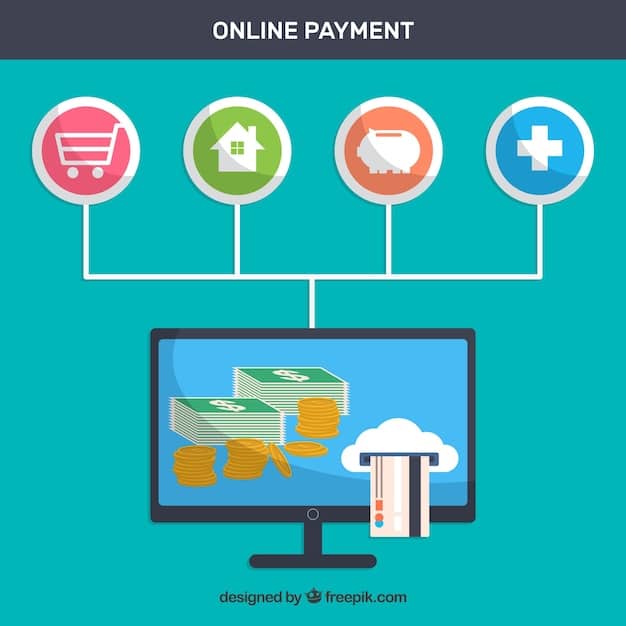Real-Time Payments Impact on US E-commerce in 2025

Real-time payments (RTP) are poised to revolutionize US e-commerce by 2025, enabling faster transactions, improved cash flow for businesses, and enhanced customer experiences through instant payment confirmations and quicker access to funds.
The landscape of e-commerce in the United States is on the cusp of a major transformation, driven by the increasing adoption of real-time payments (RTP). As we look ahead to 2025, the impact of RTP on US e-commerce, with its promise of faster transactions and improved cash flow, is set to reshape how businesses operate and consumers shop online.
The Rise of Real-Time Payments in the US
Real-time payments are rapidly gaining traction in the US, offering a significant upgrade over traditional payment methods. Unlike ACH transfers or credit card processing that can take days to settle, RTP provides near-instantaneous transactions, benefiting both merchants and consumers. This section explores the factors driving the adoption of RTP and its potential to become a dominant force in the payment ecosystem.
What are Real-Time Payments?
Real-time payments are electronic fund transfers accessible 24/7/365 that are settled almost instantaneously. This immediacy is a game-changer for businesses needing quick access to funds and consumers expecting instant transaction confirmations.
The Clearing House (TCH) and RTP
The Clearing House (TCH) operates the RTP network, a real-time payment system in the US. This network allows participating financial institutions to offer real-time payment services to their customers, fostering innovation and competition in the payments space.

Several factors are driving the adoption of RTP in the US:
- Speed: Instantaneous transactions provide immediate access to funds.
- Convenience: Available 24/7/365, RTP offers flexibility for both consumers and businesses.
- Efficiency: Reduced settlement times and automated processes cut down on administrative overhead.
- Security: Enhanced security protocols minimize the risk of fraud.
The adoption of real-time payments is poised to accelerate as more businesses and consumers recognize the benefits. The infrastructure is in place, and the demand for faster, more efficient payment solutions is growing.
Impact on E-commerce Transactions
The speed and efficiency of real-time payments are set to revolutionize e-commerce transactions in the US. By enabling instant payment confirmations and faster access to funds, RTP can enhance the overall customer experience and streamline operations for online retailers. This section delves into the specific ways RTP is impacting e-commerce transactions.
RTP offers several advantages for e-commerce transactions:
- Faster checkout: Customers experience quicker and more seamless checkout processes.
- Improved cash flow: Merchants receive funds instantly, improving their cash flow and reducing the need for costly financing.
- Reduced fraud: Enhanced security features minimize the risk of fraudulent transactions.
- Enhanced customer experience: Instant payment confirmations and faster refunds improve customer satisfaction.
Real-Time Payments and Mobile Commerce
Mobile commerce, or m-commerce, is a natural fit for real-time payments. The immediacy of RTP aligns perfectly with the on-the-go nature of mobile shopping, offering a convenient and secure payment option for smartphone users.
The Benefits for Small Businesses
Small businesses stand to gain significantly from the adoption of RTP. Faster access to funds can help them manage their cash flow more effectively, invest in growth opportunities, and compete with larger retailers.
The impact of RTP on e-commerce transactions is profound. By offering a faster, more secure, and more convenient payment option, RTP is transforming the way businesses and consumers interact online.

Improved Cash Flow for Businesses
One of the most significant benefits of real-time payments for businesses is the improvement in cash flow. Traditional payment methods often involve delays in settlement, tying up funds and creating uncertainty. RTP eliminates these delays, providing businesses with immediate access to their money.
RTP can significantly improve cash flow for businesses by:
- Accelerating receivables: Merchants receive payments instantly, reducing the time it takes to collect revenue.
- Reducing working capital needs: With faster access to funds, businesses can reduce their reliance on working capital financing.
- Improving forecasting: Real-time visibility into cash flow enables more accurate financial forecasting.
- Enabling faster payments to suppliers: Businesses can pay their suppliers instantly, strengthening relationships and potentially negotiating better terms.
Case Studies: Businesses Benefiting from RTP
Several businesses have already experienced the benefits of RTP, demonstrating its potential to transform cash flow management.
Overcoming Challenges in Cash Flow Management
Many businesses face challenges in managing their cash flow, including delays in payments, manual reconciliation processes, and a lack of real-time visibility. RTP can help overcome these challenges by automating processes, providing instant transaction data, and accelerating the flow of funds.
The impact of RTP on business cash flow is substantial. By providing faster access to funds, RTP empowers businesses to manage their finances more effectively and invest in growth.
Enhanced Security and Fraud Prevention
Security is a paramount concern in e-commerce, and real-time payments offer enhanced security features compared to traditional payment methods. By leveraging advanced encryption and authentication protocols, RTP can minimize the risk of fraud and protect sensitive financial data.
RTP enhances security and fraud prevention through:
- Tokenization: Replacing sensitive card data with unique tokens that are useless to fraudsters.
- Real-time monitoring: Continuous monitoring of transactions for suspicious activity.
- Multi-factor authentication: Requiring multiple forms of verification to authenticate transactions.
- Data encryption: Protecting sensitive data with advanced encryption protocols.
Compliance and Regulatory Considerations
As with any payment system, RTP is subject to compliance and regulatory requirements. Businesses must adhere to these requirements to ensure the security and integrity of their transactions.
The Future of Fraud Prevention in E-commerce
The fight against fraud in e-commerce is an ongoing battle. RTP is just one tool in the arsenal, but it offers a significant advantage by providing enhanced security features and real-time monitoring capabilities.
The security benefits of RTP are clear. By leveraging advanced technology and robust authentication protocols, RTP provides a more secure payment option for e-commerce transactions.
Challenges and Considerations for Adoption
While the benefits of real-time payments are compelling, there are also challenges and considerations that businesses must address before adopting this technology. These include integration costs, interoperability issues, and the need for employee training.
Challenges and considerations for adopting RTP include:
- Integration costs: Implementing RTP requires investment in new technology and infrastructure.
- Interoperability: Ensuring seamless integration with existing payment systems.
- Employee training: Training employees on the use of RTP and its security protocols.
- Customer adoption: Encouraging customers to adopt RTP as a payment option.
Strategies for Successful Implementation
Despite the challenges, businesses can successfully implement RTP by developing a clear strategy, investing in the right technology, and providing adequate training to employees.
The Role of Fintech Companies
Fintech companies are playing a key role in driving the adoption of RTP by providing innovative solutions and making it easier for businesses to integrate with the RTP network.
Overcoming the challenges and addressing the considerations associated with RTP adoption is essential for businesses looking to reap the benefits of this technology.
Real-Time Payments in 2025: Predictions and Projections
Looking ahead to 2025, the adoption of real-time payments in the US is expected to continue to grow, driven by increasing demand for faster, more efficient payment solutions. Experts predict that RTP will become a mainstream payment option, transforming the way businesses and consumers interact online.
Market Growth and Adoption Rates
Analysts project significant growth in the RTP market over the next few years, with adoption rates expected to increase as more businesses and consumers recognize the benefits.
The Impact on Traditional Payment Methods
The rise of RTP is likely to disrupt traditional payment methods, such as ACH transfers and credit card processing, as businesses and consumers seek faster and more convenient alternatives.
The Future of E-commerce Payments
Real-time payments are set to play a key role in the future of e-commerce payments. By offering a faster, more secure, and more efficient payment option, RTP is transforming the way businesses and consumers transact online.
The future of real-time payments in the US is bright. As adoption rates continue to grow and technology evolves, RTP is poised to revolutionize e-commerce and transform the payments landscape.
| Key Aspect | Brief Description |
|---|---|
| 🚀 Faster Transactions | RTP enables virtually instant payment processing. |
| 💰 Improved Cash Flow | Businesses gain quicker access to funds. |
| 🛡️ Enhanced Security | RTP reduces fraud risk with real-time monitoring. |
| 📱 Mobile Commerce | Ideal fit for on-the-go payments. |
Frequently Asked Questions
▼
Real-time payments offer faster transactions, improved cash flow due to quicker access to funds, enhanced security features to minimize fraud, and an improved customer experience with instant payment confirmations.
▼
Real-time payments accelerate receivables, reduce working capital needs by providing quicker access to funds, improve financial forecasting with real-time visibility, and facilitate faster payments to suppliers.
▼
RTP uses tokenization to protect sensitive card data, real-time monitoring to detect suspicious activity, multi-factor authentication to verify transactions, and data encryption to secure data in transit and at rest.
▼
Challenges include the costs associated with integrating new technology, ensuring interoperability with existing payment systems, the need for employee training, and driving customer adoption of real-time payment options.
▼
Fintech companies play a key role by providing innovative solutions that simplify integration with the RTP network and make it easier for businesses to implement and manage real-time payment systems.
Conclusion
As we approach 2025, the impact of real-time payments on US e-commerce is undeniable. With faster transactions, improved cash flow for businesses, and enhanced security features, RTP is poised to transform the way we shop online, offering a more efficient and convenient experience for both merchants and consumers. Embracing this technology is essential for businesses looking to thrive in the evolving e-commerce landscape.





